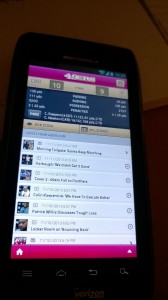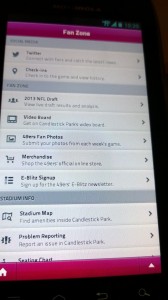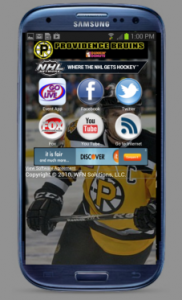Since Candlestick is going to be all blowed up after this season, it’s probably not fair to single out the Niners’ app and network for poor performance this year. I mean, why build a Wi-Fi network in a place that’s going to be torn down? I will say that the new DAS seems to be working well, since I had no problems getting a cell signal all day. But when I tried to watch live video via the Niners app, it told me I had to be on stadium Wi-Fi to watch video.
But the Wi-Fi network wouldn’t connect. After long minutes and several attempts. Finally I gave up. I tried my Verizon NFLMobile app, which lets me watch RedZone on Sundays. But no! Verizon NFLMobile, which monitors your location via GPS, won’t let you watch live video or RedZone while in an NFL stadium. The only person around us with live video of anything NFL on his phone was a guy who gets the Sunday Ticket service from DirecTV. Tell me, if you’re a fan, you’re not frustrated with the idiotic hurdles the NFL puts in front of its best content to satisfy its rights deals. Guys, you’ve had several years to figure this out. It’s the biggest C’mon Man I can think of. LET US WATCH LIVE VIDEO! MAKE IT EASY!
Again to be clear: This isn’t an app review, or a formal survey. But just looking at all the phone use in the stands, I didn’t see anyone else on the Niners team app. I saw a lot of people on Facebook, on Instagram, on Twitter. Or just sending picture and text messages. What is the common thread for those apps? They are simple to use, they are fast, they have great and easy interfaces on a mobile phone. They are already filled with the people who I want to follow or communicate with. With any one of those apps, you are doing something within one or two clicks.
With the team apps, that’s just not the case. The Niners app — which looks like a lot of other team apps, since it’s built by stadium app market leader YinzCam — is incredibly dense, with lots of very small type. Which, while it looks OK in a screenshot like the ones here, is almost impossible to see in the harsh outdoor light of a stadium. Opening it up for the first time at the Niners game, I was underwhelmed by the overload of information and choices available. And then when the live video didn’t work… I mean, really, what else is there in the team app that could be different, or make me want to go there?Stats? Yardages? That stuff isn’t crucial to people sitting in the stands. Where the team app could really make a difference is if it gave detailed information on what just happened in front of my eyes — you know, the kind of stuff that is instantly delivered to people at home watching games on their couch. Someone is hurt? Injured? You’re up there in the stands, you have no idea of what happened or why there are people standing around on the field. I couldn’t find an audio feed of the TV broadcast on the team app — why not have that available? Or at least the radio simulcast? What about that last play? Was it a fumble? How did Vernon Davis get a concussion? In the stands, you have one chance to see what happens. And in many cases, no way of knowing what the outcome was, especially since most teams (Niners included) only show replays of “positive” events for the home team. Again: treating fans like idiots or children is no way to make the stadium a better experience.
My simple thought, as I switched back to Twitter — where, by following some of the beat writers who cover the Niners, I was able to get almost-instant info from their press box tweets — is that the team apps seem designed to be sold to the teams and the leagues, and not with the fan in mind. I have no desire to go to the Niners’ app to find other people on Twitter to interact with or follow. If public sports websites are any guide, anything open to the public is already overrun by ignorant trolls. I’ll stick with my own Twitter feed, thanks. And now that Twitter is adding in NFL highlights, I probably have a better chance of seeing live video there than via the team apps. How are team apps, with their rights restrictions, clunky design and team-sanitized information, going to keep up with fast-moving folks like Twitter, especially now with tools like Vine or Instagram video? Anyone want to bet that we start seeing more fan replay videos on Twitter before we get good, easy to get official team replays?
Maybe these apps are working better in other stadiums, where the networks are better. My guess is, even at those places there is slow uptake. If teams really want to use technology to make the stadium a better experience than the couch, they’ve got to do more to make connecting easier. The network hookup needs to be drop dead simple. If I don’t have Wi-Fi turned on, the app should figure out how to do that itself. (Or ask when it’s first opened up, not after I’ve gone three clicks in to find the “live video” button.) Activities should be one or two clicks, not a laundry list of choices and treed menus. Though there is a lot of down time at games, it’s not that long. Apps should work faster than a play clock… if you can’t get there in 45 seconds, it’s a fail.
Safe to say, we are going to cover app development AND uptake as part of our stadium technology focus. I think right now it is the weak link in the whole connected stadium equation. One scene on the way out of the Niners game made me realize just how far behind the apps are; instead of staying in their seats to watch the crucial possible last-minute drive, many San Francisco fans were outside on the concourse… watching the TV coverage on the high-def screens above the concession stands. Because on TV, they know, they will get multiple replay angles and explanations. These fans weren’t bad fans for leaving their seats. They were, actually, just trying to find the best game-viewing experience. They should be the people interviewed next about what should be in a team app. Because what’s there now obviously isn’t reaching them. Or keeping them in their seats.









